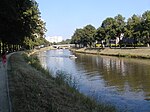Gent-Dampoort railway station
1861 establishments in BelgiumBelgian railway station stubsBuildings and structures in GhentRailway stations in BelgiumRailway stations in East Flanders ... and 2 more
Railway stations opened in 1861Transport in Ghent

Gent-Dampoort is the second largest railway station in Ghent, East Flanders, Belgium. The station opened on 15 June 1861 on the Lines 58 and 59. The train services are operated by NMBS/SNCB. The current building was built in 1973 by architects Dirk Servaes and Johan Beyne. The railway station is situated in the neighbourhood Dampoort in Ghent.
Excerpt from the Wikipedia article Gent-Dampoort railway station (License: CC BY-SA 3.0, Authors, Images).Gent-Dampoort railway station
Antwerpenplein, Ghent
Geographical coordinates (GPS) Address Nearby Places Show on map
Geographical coordinates (GPS)
| Latitude | Longitude |
|---|---|
| N 51.055555555556 ° | E 3.7408333333333 ° |
Address
Gent-Dampoort
Antwerpenplein
9000 Ghent (Ghent)
East Flanders, Belgium
Open on Google Maps







